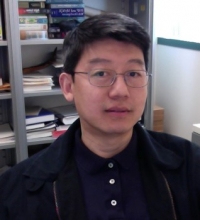CBE Seminar: Biomolecular Simulation - Methodology Advancements and Applications

Department of Molecular Biology and Biochemistry
UC Irvine
Abstract: Molecular simulation has become an important tool in modern computational chemistry and biochemistry. Nevertheless, the accuracy and efficiency of the approach still need further improvement to achieve the goal of robust and predictive simulation, particularly for large and complex biomolecular systems. The accuracy issue arises from the intrinsic limitations of classical models that have to be used to approximate the quantum molecular processes. The efficiency issue is a direct consequence of the high dimensionality of biomolecular systems: sophisticated molecular machines are complexes of thousands to millions of atoms. What further complicates the picture is the need to realistically model the interactions between biomolecules and their surrounding water molecules. In this talk, I will review our developments of biomolecular simulation models and methods and their applications to interesting biomedical systems from cancer biology and biosynthesis of natural products.
Bio: Ray Luo, joined the faculty of the UC Irvine Department of Molecular Biology and Biochemistry in 2001. He is also a faculty member in the Departments of Biomedical Engineering, Chemical and Biomolecular Engineering, and Materials Science and Engineering. He obtained his doctorate in computational structural biology at the University of Maryland Biotechnology Institute, and was a research fellow at the University of California San Francisco.
His lab's research interests are in the general area of computational structural biology and biophysics. They are particularly interested in computational analysis of solvation-mediated electrostatics and polarization effects in biomolecules. They also improved the approach to model nonpolar solvation interactions. Accurate modeling of these important interactions is crucial in studies of molecular recognition and applications to drug design and discovery. In addition, they are developing new biomolecular mechanics force fields with explicit representation of electronic polarization for accuracy and reduced or coarse-grained representation for efficiency. To maximize the impact of their research efforts, they have been packaging their computer models and algorithms in Amber/AmberTools, one of the most popular packages in biomolecular modeling. Together with their collaborators, they are investigating a wide range of interesting problems of biomedical importance, including cancer biology, biosynthesis and synthetic biology.
In the last 10 years, his group’s research has been highlighted in 73 peer-reviewed papers and reviews and 18 software releases. The impact of his lab's research, as measured by the literature citations of publications and software packages, has increased significantly in the same period, reaching approximately 2,200 citations per year on average in the last seven calendar years. The H-index of their publications and software packages is 45.
Host: Han Li
Share
Upcoming Events
-
MSE 298 Seminar: Mechano-Electrochemical Phenomena at Ceramic Electrolyte Interfaces
-
MSE 298 Seminar: Innovation In Materials Science - An Industrial R&D Perspective
-
MSE 298 Seminar: Understanding the Impact of Grain Boundary Inclination on Grain Growth Using Modeling and Simulation and Experiments
-
EECS Seminar: Mixed Conductors for Bioelectronics
-
MSE 298 Seminar: Ionic Correlations in Polymer Nanostructures - From Block Copolymers to End-Charged Blends
